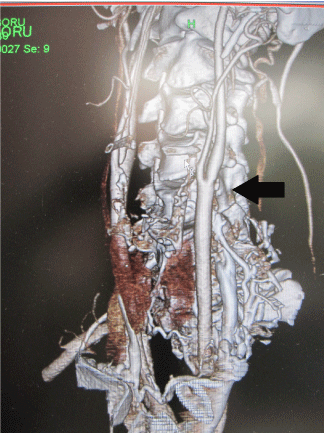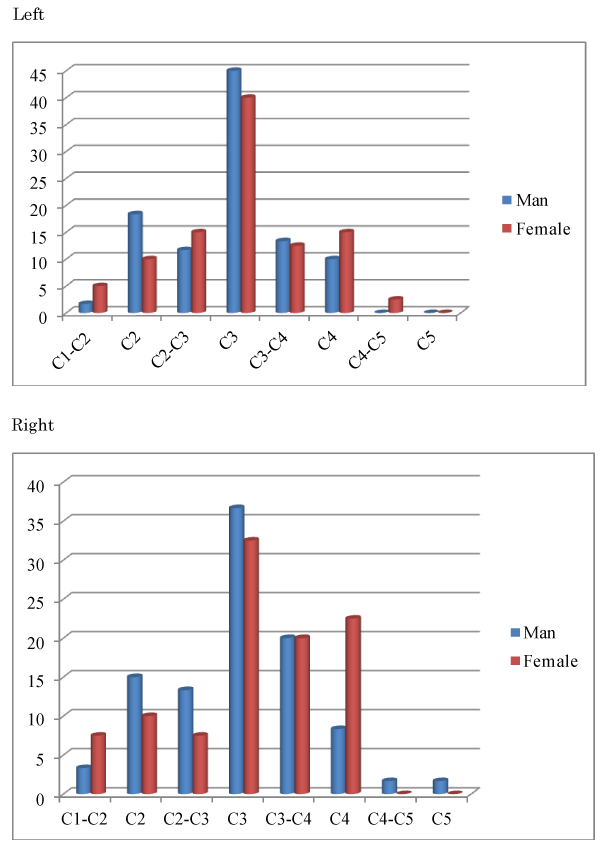| Research Article |
Open Access |
|
| Satoshi Furukawa*, Lisa Wingenfeld, Akari Takaya, Tokiko Nakagawa, Ikuo Sakaguchi and Katsuji Nishi |
| Department of Legal Medicine, Shiga University of Medical Science, Shiga, Japan |
| *Corresponding authors: |
Satoshi Furukawa MD
Department of Legal Medicine
Shiga University of Medical Science
Setatsukinowa, Otsu City, Shiga 520- 2192, Japan
Tel: +81-77-548-2202
E-mail: 31041220@belle.shiga-med.ac.jp |
|
| |
| Received February 16, 2012; Published July 03, 2012 |
| |
| Citation: Furukawa S, Wingenfeld L, Takaya A, Nakagawa T, Sakaguchi I, Nishi K (2012) Morphological Variation of the Carotid Artery Bifurcation Level. 1: 135. doi:10.4172/scientificreports.135 |
| |
| Copyright: © 2012 Furukawa S, et al. This is an open-access article distributed under the terms of the Creative Commons Attribution License, which permits unrestricted use, distribution, and reproduction in any medium, provided the original author and source are credited. |
| |
| Abstract |
| |
| Knowledge of carotid bifurcation is important for vascular surgical procedures in the region, such as carotid endarterectomy or radical neck dissection, catheterization and aneurysms. Carotid sinus hypersensitivity is an exaggerated response to carotid sinus baroreceptor stimulation. Bradycardia, hypotension, and syncope are common manifestations of carotid sinus hypersensitivity. The aim of this study was to describe the common carotid artery bifurcation. 100 subjects were evaluated in computed tomography angiography (CTA) and the bifurcation level according to the cervical vertebra level was investigated. We showed the anatomical variation of carotid sinus location. |
| |
| Keywords |
| |
| Carotid artery bifurcation; Morphological variation; CT angiography |
| |
| Introduction |
| |
| The common carotid artery, external carotid artery and internal carotid artery are the main arterial supplies to the head and neck [1]. In head and neck surgery, the common carotid arteries are important landmarks, defining the plane of the dissection during radical neck surgery [2]. Reported common causes for bradycardia include anesthetic agents, central neural blockage, and vagal reflex by surgical stimulus [3]. Compared to other causes, prediction of occurrence of the vagal reflex is difficult. Therefore, if procedures used during surgery involve the carotid sinus, innervated by the vagus nerve, the possibility of triggering arrhythmia or hypotension should be considered. Accurate evaluation of the carotid bifurcation level with non invasive techniques remains an important goal and external anatomical landmarks can be clinically useful in predicting the bifurcation level of the carotid artery. The objective of the present study was to correlate the common carotid artery bifurcation level with the cervical vertebra level. We examined the variability of carotid sinus location. |
| |
| Materials and Methods |
| |
| 100 subjects were randomly selected in in-patient and out-patient. All measurements were performed on 100 subjects (40 female and 60 male), ranging in age from 18 to 104 years. The subjects were candidates for computed tomography angiography (CTA). The study was approved by the ethical committee of our university. However, the ethics committee waived the need for consent from the patients’ next of kin. Carotid bifurcation level was compared to the level of cervical vertebra. Most of carotid bifurcations (CB) were found at the level of C3. The vertebra level of CB was differently distributed in distance of the whole neck measured along the vertebral column between upper borders of C1-C2 to lower border of C5. (Figure 1) 54% of the level of CB was asymmetrical between the right and left side. To illustrate the diversity that may occur in the location of the carotid sinus, CTA of the carotid bifurcation were obtained and matched to the cervical vertebra images. (Figure 2) Anatomical locations of the carotid sinus bifurcation indicated wide variability. |
| |
|
|
Figure 1: Distribution of the CB position in studied cases according to the cervical vertebrae level. |
|
| |
|
|
Figure 2: CT angiography images of variation in carotid bifurcation location. The location of the CB to the corresponding level of cervical vertebrae. |
|
| |
| Discussion |
| |
| In case of high bifurcation, the embolic material could extend into the common carotid artery instead of the external carotid artery with subsequent stroke [4]. Additionally, the exact bifurcation site and arterial variations of the common carotid artery are clinically important in many other procedures, such as ligation of the external carotid artery, intra-arterial administration of chemotherapeutic agents, interpretation of digital subtraction angiography, and during radical neck dissection [5-7]. Investigations have observed that the ratio of mortality and morbidity of high-level carotid bifurcation cases after carotid endarterectomy attempt are quite high. They have noticed that especially nerve injury is too much when the surgical operation has been performed these cases [8]. Carotid sinus hypersensitivity is an exaggerated response of the carotid sinus baroreceptor to local stimulation. According to Kim et al. the incidence of intraoperative carotid sinus hypersensitivity was 28% in elderly patients, and 10% in young patients undergoing radical neck dissection. Therefore, tight monitoring of the patient’s pulse rate and blood pressure is recommended in such surgery [9]. The carotid sinus is located on the internal carotid artery bifurcation and plays a central role in maintenance of homeostasis of blood pressure [10]. In the carotid sinus reflex, atrioventricular conduction delays, resulting in bradycardia and decreased sympathetic vascular tone, causing hypotension by enhancement of parasympathetics [11]. It is commonly accepted that the carotid artery bifurcation occurs about the level of C âÃ⦣ for radiological purpose [12]. |
| |
| The clinically relevant variations of the location of carotid bifurcation should be considered by surgeons performing procedures in neck area. Risky surgical processes for stimulation of the carotid sinus should also be discussed with the surgeon before and during surgery. Anesthesiologists should pay more attention to vital sign monitoring and thorough preparations for emergency for surgical procedures that involve manipulation of the carotid sinus. |
| |
| |
| References |
| |
- Lucev N, Bobinac D, Maric I, Drescik I (2000) Variations of the great arteries in the carotid triangle. Otolaryngol Head Neck Surg 22: 590-591.
- Ord RA, Ward-Booth RP (1986) Anomalies of the common carotid artery: A rare complication of radical neck dissection. Br J Oral Maxillofac Surg 24: 405-409.
- Ngamprasertwong P, Kositanurit I, Yokanit P, Lerdsirisopon S, Pulnitiporn A, et al. (2009) The Thai Anesthesia Incident Monitoring study: perioperative arrhythmia. J Med Assoc Thai 92: 342-350.
- Trigaux JP, Delchambre F, VanBeers B (1990) Anatomical variation of the carotid bifurcation: implications for digital subtraction angiography and ultrasonography. Br J Radiol 63: 181-185.
- Gluncic V, Petanjek Z, Marusic A, Gluncic I (2001) High bifurcation of common carotid artery, anomalous origin of ascending pharyngeal artery and anomalous origin of ascending pharyngeal artery and anomalous branching pattern of external carotid artery. Surg Radiol Anat 23: 123-125.
- Riles TS, Berenstein A, Fischer FS, Persky MS, Madrid M (1993) Reconstruction of the ligated external carotid artery for embolization of cervicofacial arteriovenous malformations. J Vasc Surg 17: 491-498.
- Roberts LK, Gerald B (1978) Absence of both common carotid arteries. AJR Am J Roentgenol 130: 981-982.
- Ballotta E, Da Giau G, Renon L, Narne S, Saladini M, et al. (1999) Cranial and cervical nerve injuries after carotid endarterectomy: a prospective study. Surgery 125: 85-91.
- Kim TI, Lim HJ, Chang SH, Kim NS (1998) Intraoperative carotid sinus hypersensitivity and postoperative complication of radical neck dissection retrospective study. Korean J Crit Care Med 13: 49-54.
- Thomas JE (1969) Hyperactive carotid sinus reflex and carotid sinus syncope. Mayo Clin Proc 44: 127-139.
- Muntz HR, Smith PG (1983) Carotid sinus hypersensitivity: a cause of syncope in patients with tumors of the head and neck. Laryngoscope 93: 1290-1293.
- Vitek JJ, Reaves P (1973) Thoracic bifurcation of the common carotid artery. Neuroradiology 5: 133-139.
|
| |
| |


